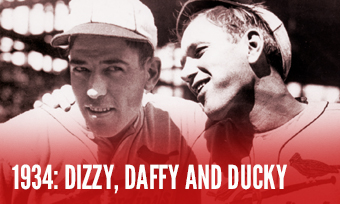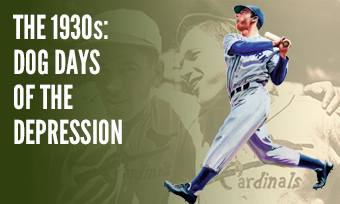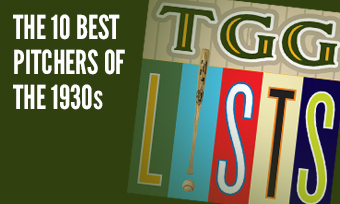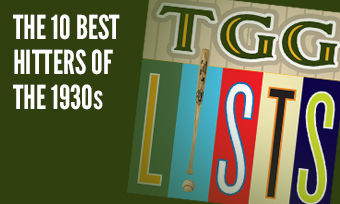The Yearly Reader
Leaders and Honors, 1934
Our list of baseball’s top 10 hitters and pitchers in both the American League and National League for the 1934 baseball season, as well as the awards and honors given to the game’s top achievers of the year.
The National League’s Top 10 Hitters, 1934
Bold type in brick red indicates league leader.
1. Mel Ott, New York
Key Numbers: .326 average, 119 runs, 190 hits, 29 doubles, 10 triples, 35 home runs, 135 RBIs, 85 walks, 13 intentional walks.
For the second of three times in his Hall-of-Fame career, Ott had to share the home run crown at season’s end—this time with #2 below.
2. Ripper Collins, St. Louis
Key Numbers: 154 games, .333 average, 116 runs, 200 hits, 40 doubles, 12 triples, 35 home runs, 128 RBIs, .615 slugging percentage.
Lost in the Dizzy Dean media circus at St. Louis was the dazzling offensive tear of Collins, the brief wonder who was never better than in 1934.
3. Paul Waner, Pittsburgh
Key Numbers: .362 average, 122 runs, 217 hits, 32 doubles, 16 triples, 14 home runs, 90 RBIs, 68 walks.
The Pirates’ hitting machine scooped up the league’s top batting average and hit total for the second time in his career.
4. Arky Vaughan, Pittsburgh
Key Numbers: .333 average, 115 runs, 186 hits, 41 doubles, 11 triples, 12 home runs, 94 RBIs, 94 walks, .431 on-base percentage.
A tough July kept Vaughan from competing with Waner for the NL batting title—something he’d take care of the following season.
5. Joe Medwick, St. Louis
Key Numbers: .319 average, 110 runs, 198 hits, 40 doubles, 18 triples, 18 home runs, 106 RBIs.
“Ducky” scored and knocked in at least 100 runs each for the first of five straight years; his 18 triples registered as a career high.
6. Wally Berger, Boston
Key Numbers: .298 average, 92 runs, 183 hits, 35 doubles, 8 triples, 34 home runs, 121 RBIs.
Berger had five multiple-homer games as he continued to carry the Braves on his back offensively.
7. Bill Terry, New York
Key Numbers: .354 average, 109 runs, 213 hits, 30 doubles, 8 home runs, 83 RBIs, 60 walks.
The Giants’ player-manager excelled once more at the plate, but people will remember the 1934 season as the one he should have kept his mouth shut about the Brooklyn Dodgers.
8. Chuck Klein, Chicago
Key Numbers: 115 games, .301 average, 78 runs, 27 doubles, 20 home runs, 80 RBIs.
Some believe that Klein’s muted numbers in his first year with the Cubs had much to do with his absence from Philadelphia’s stat-happy Baker Bowl, but playing on a bum leg for much of the year also had a bit to do with it.
9. Johnny Moore, Cincinnati-Philadelphia
Key Numbers: .330 average, 35 doubles, 7 triples, 11 home runs, 98 RBIs.
Unable to find a rhythm in Cincinnati, Moore was dealt to the Phillies, from whom he smashed all 11 of his homers and hit .343—.381 at hit-happy Baker Bowl.
10. Sam Leslie, Brooklyn
Key Numbers: .332 average, 181 hits, 29 doubles, 9 home runs, 102 RBIs, 69 walks.
At first the Dodgers looked as if they had got the raw deal in obtaining Leslie for Lefty O’Doul and Watty Clark a year before—but in 1934, Leslie shined while the two other two depreciated.
The American League’s Top 10 Hitters, 1934
1. Lou Gehrig, New York
Key Numbers: 154 games, .363 average, 128 runs, 210 hits, 40 doubles, 6 triples, 49 home runs, 166 RBIs, 109 walks, .465 on-base percentage, .706 slugging percentage.
Like Mel Ott, Gehrig was a New York “nice guy” who proved nasty on opposing pitchers; his rude treatment was worth a triple crown, the AL’s second in a row. He might have collected nine triples, but three of them were washed away in a single game at Washington’s voluminous Griffith Stadium when rain halted a game before it became official. Despite all of the above, Gehrig finished just fifth in the AL MVP vote.
2. Jimmie Foxx, Philadelphia
Key Numbers: .334 average, 120 runs, 180 hits, 28 doubles, 44 home runs, 130 RBIs, 111 walks, 17 intentional walks, 11 stolen bases.
Not even Foxx’ continued greatness could keep the A’s from recording their first losing record in 10 years.
3. Hank Greenberg, Detroit
Key Numbers: .339 average, 118 runs, 201 hits, 63 doubles, 7 triples, 26 home runs, 139 RBIs, 63 walks.
Greenberg’s breakout year included the fourth-highest season total of doubles in history, and two home runs on September 10 against the Red Sox after being given the green light to play on Jewish New Year by a local rabbi.
4. Charlie Gehringer, Detroit
Key Numbers: 154 games, .356 average, 135 runs, 214 hits, 50 doubles, 7 triples, 11 home runs, 127 RBIs, 99 walks, 11 stolen bases.
Right behind Lou Gehrig in the AL batting race—as well as the baseball encyclopedia, alphabetically—was Charlie Gehringer.
5. Hal Trosky, Cleveland
Key Numbers: 154 games, .330 average, 117 runs, 206 hits, 45 doubles, 9 triples, 35 home runs, 142 RBIs.
A scintillating debut for the 21-year-old rookie first baseman—who was not to be confused with ex-Lenin sidekick Leon Trotsky—as he played every inning of every game for the Indians.
6. Earl Averill, Cleveland
Key Numbers: 154 games, .313 average, 128 runs, 187 hits, 48 doubles, 6 triples, 31 home runs, 113 RBIs, 99 walks.
Averill felt back at home in Cleveland’s cozy League Park after struggling to fuel his power stroke at nearby, monstrous Cleveland Stadium.
7. Al Simmons, Chicago
Key Numbers: .344 average, 102 runs, 192 hits, 36 doubles, 7 triples, 18 home runs, 104 RBIs.
Bucketfoot Al’s miserable experience at Comiskey Park continued, even as the White Sox brought in the fences (actually, they moved home plate closer to the wall) to feed his power-driven ego; despite another stellar overall average, the home runs still weren’t a ‘coming.
8. Bob Johnson, Philadelphia
Key Numbers: .307 average, 111 runs, 168 hits, 26 doubles, 34 home runs, 92 RBIs, 12 stolen bases.
The second-year Athletic made like Babe Ruth’s instant heir, slamming 20 homers in his first 50 games before cooling off.
9. Bill Werber, Boston
Key Numbers: .321 average, 129 runs, 200 hits, 41 doubles, 10 triples, 11 home runs, 77 walks, 40 stolen bases.
Werber was the sole pleasant surprise among the many pricey underachievers brought into the Red Sox fold by new owner Tom Yawkey.
10. Babe Ruth, New York
Key Numbers: 125 games, .288 average, 78 runs, 22 home runs, 84 RBIs, 104 walks.
The Bambino’s fading swan song at Yankee Stadium paled to his earlier years of legend, but averaging nearly a walk per game showed that opposing pitchers were still heavily weary of his presence.
The National League’s Top 10 Pitchers, 1934
1. Carl Hubbell, New York
Key Numbers: 2.30 ERA, 21 wins, 12 losses, 8 saves, 49 appearances, 35 starts, 25 complete games, 313 innings, 37 walks.
Despite Dizzy Dean’s spectacular scene-steal of a season, chances are the experts would have still picked Hubbell to be their guy if their lives depended on it. (But then again, he was a combined 1-4 against Dizzy and Daffy Dean.)
2. Dizzy Dean, St. Louis
Key Numbers: 2.66 ERA, 30 wins, 7 losses, .811 win percentage, 50 appearances, 33 starts, 7 shutouts, 311.2 innings, 195 strikeouts.
Dean entered the books as the NL’s last 30-game winner to date with the help of the hometown scorer, who credited him with two victories that really should have gone to others.
3. Curt Davis, Philadelphia
Key Numbers: 2.95 ERA, 19 wins, 17 losses, 5 saves, 51 appearances, 31 starts, 274.1 innings.
The rookie gave the Phillies something they hadn’t seen in ages: Quality pitching.
4. Lon Warneke, Chicago
Key Numbers: 3.21 ERA, 22 wins, 10 losses, .688 win percentage, 43 appearances, 35 starts, 291.1 innings.
The Cubs’ ace started the year in style, throwing one-hitters in each of his first two outings—including an Opening Day outing in which he didn’t give up his first hit until one out in the ninth.
5. Freddie Fitzsimmons, New York
Key Numbers: 3.04 ERA, 18 wins, 14 losses, 38 appearances, 37 starts, 263.1 innings, 51 walks, 32 grounded into double plays.
The veteran pitcher’s nine-year run of consistent success at New York would come to an end as the wear and tear would catch up to his arm the following season. Yet he would continue as a major leaguer all the way to just short of his 42nd birthday.
6. Hal Schumacher, New York
Key Numbers: 3.18 ERA, 23 wins, 10 losses, .697 win percentage, 41 appearances, 297 innings, 10 wild pitches.
Sandwiched in between a pair of 19-win campaigns was Schumacher’s only finish above 20; hitting six home runs on his own didn’t hurt the effort. (And if you’re thinking he benefitted with cheap homers down the short lines of the Polo Grounds, think again; five of those six came on the road.)
7. Waite Hoyt, Pittsburgh
Key Numbers: 2.93 ERA, 15 wins, 6 losses, .714 win percentage, 48 appearances, 17 starts, 43 walks.
The primary ace of the great Yankees teams of the 1920s, Hoyt finally found a stable home in Pittsburgh as one of the NL’s stingiest relievers after bouncing about the previous three years. (Hoyt’s bullpen ERA was 1.89; when he started, it was 3.62.)
8. Roy Parmalee, New York
Key Numbers: 3.42 ERA, 10 wins, 6 losses, 22 appearances, 21 starts.
A modest but solid campaign for Parmalee, who missed two months early on after undergoing an appendectomy.
9. Van Lingle Mungo, Brooklyn
Key Numbers: 3.37 ERA, 18 wins, 16 losses, 45 appearances, 38 starts, 315.1 innings, 104 walks.
Sure, the man whose name could be a tongue-twister for annunciation test participants was the workhorse of the year—but still, a 3.37 ERA is impressive considering he gave up more hits (300), walks, doubles (62) and triples (15) than anyone else.
10. Paul Dean, St. Louis
Key Numbers: 3.44 ERA, 19 wins, 11 losses.
The “quiet” Dean was muted through the season’s first half with an ERA teetering near 5.00, before turning up the volume the rest of the way; the highlight down the stretch was a September 21 no-hitter—something his star-studded brother never accomplished.
The American League’s Top 10 Pitchers, 1934
1. Lefty Gomez, New York
Key Numbers: 2.33 ERA, 26 wins, 5 losses, .839 win percentage, 38 appearances, 33 starts, 25 complete games, 6 shutouts, 281.2 innings, 158 strikeouts.
One Lefty (Gomez) replaced another (sore-armed Grove) as the AL’s dominant ace.
2. Mel Harder, Cleveland
Key Numbers: 2.61 ERA, 20 wins, 12 losses, 4 saves, 44 appearances, 29 starts, 6 shutouts, 255.1 innings.
After getting hosed the year before at monstrous Cleveland Stadium with a league-leading ERA but sub-.500 record, Harder and the Indians returned to bandboxed League Park where his ERA actually dropped—it was actually 1.98 at home—as greatly enhanced support from his mates got him to 20 wins for the first time in his career.
3. Schoolboy Rowe, Detroit
Key Numbers: 3.45 ERA, 24 wins, 8 losses, .750 win percentage, 45 appearances, 30 starts, 266 innings.
In his first full (and best) season, Rowe joined the long list of AL pitchers who worked up a 16-game win streak—but couldn’t make it to 17. He also hit over .300 for the first of two straight years.
4. Johnny Murphy, New York
Key Numbers: 3.12 ERA, 14 wins, 10 losses, 4 saves, 40 appearances, 20 starts.
The future closer for the Yankees proved himself as a worthy part-time starter in his rookie campaign.
5. Tommy Bridges, Detroit
Key Numbers: 3.67 ERA, 22 wins, 11 losses, .667 win percentage, 36 appearances, 35 starts, 275 innings.
Armed with the best curve of his generation, Bridges won at least 20 games for the first of three successive years; it didn’t hurt that he was given six runs’ worth of support per start.
6. Red Ruffing, New York
Key Numbers: 3.93 ERA, 19 wins, 11 losses, 256.1 innings.
The guy whose ERA never went below 4.00 for the Red Sox and never above it with the Yankees kept it below that figure thanks to the year’s longest (29.2) consecutive scoreless inning streak.
7. Bobby Burke, Washington
Key Numbers: 3.21 ERA, 8 wins, 8 losses, 37 appearances, 15 starts.
A fabulous home stretch (4-2, 1.46 ERA over his last seven outings, all starts) rescued Burke’s season and separated him from a list of disappointing staff teammates.
8. EldEn Auker, Detroit
Key Numbers: 3.42 ERA, 15 wins, 7 losses, 43 appearances, 18 starts, 205 innings.
With long-time reliever Firpo Marberry in decline, the 22-year-old Auker took over as the Tigers’ primary relief man.
9. Wes Ferrell, Boston
Key Numbers: 3.63 ERA, 14 wins, 5 losses, 26 appearances, 23 starts.
The high-strung ace made the most of a late start after a refusal to report to Cleveland camp precipitated a trade to the Red Sox.
10. Bobo Newsom, St. Louis
Key Numbers: 4.01 ERA, 16 wins, 20 losses, 5 saves, 47 appearances, 32 starts, 262.1 innings, 149 walks.
It only made sense that Newsom’s AL debut—initiating a long and meandering run through the Junior Circuit—would be epitomized by a nine-inning no-hitter he would lose (along with the game) in the 10th late in the year against the Red Sox.









